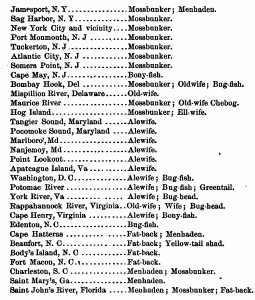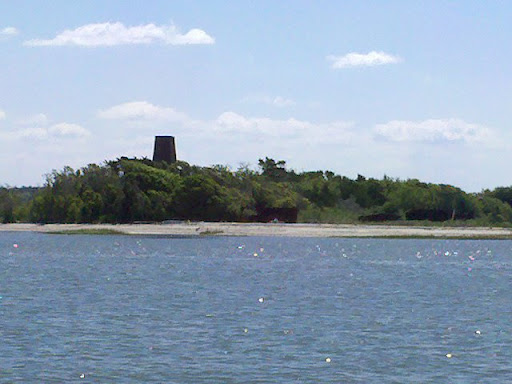Yesterday, the Atlantic States Marine Fisheries Council voted to reduce the catch of Menhaden by as much as 37%. Menhaden, often referred to as the “most important fish in the sea” have been declining precipitously over the last several decades, due largely to the Menhaden reduction industry, which is now supported by a single company. Several graphs have been produced recently to illustrate this decline, including this incredibly informative illustration. Despite this attention, most of these reports have missed the big picture. Amy and myself have been thinking quite a bit about shifting baselines recently, and Menhaden represent what may be the most extreme example of this phenomenon.
The population of Menhaden along the eastern seaboard crashed in 1879 a full century earlier than the decline documented here. In it’s heyday, the menhaden industry was catching seven hundred million fish annually. Last years harvest was barely 450 million. These numbers belie a massive ecologic change. While the historic menhaden industry was based north of Cape Cod, our current menhaden production focusses on the mid-Atlantic seaboard and is slowly moving south, chasing the remaining fish. The population that today has finally received protection is a remnant of the once massive foundation of the pelagic ecosystem.
Reprinted below is our original article, the Menhaden of History.

 Menhaden was the most important fisheries throughout American history. When the first settlers learned to farm corn, it was with menhaden that they fertilized the seeds. When the whaling industry reached its height, it was outweighed by menhaden oil. Menhaden ruled the ocean from the middle of the food chain, they were the dominant prey of most large predatory fish. They swarmed the sea in schools several miles long and millions of fish deep, their huge biomass supported by plankton. They regulated algal blooms, mediated the transfer of primary production up the food chain, and filtered the ocean.
Menhaden was the most important fisheries throughout American history. When the first settlers learned to farm corn, it was with menhaden that they fertilized the seeds. When the whaling industry reached its height, it was outweighed by menhaden oil. Menhaden ruled the ocean from the middle of the food chain, they were the dominant prey of most large predatory fish. They swarmed the sea in schools several miles long and millions of fish deep, their huge biomass supported by plankton. They regulated algal blooms, mediated the transfer of primary production up the food chain, and filtered the ocean.
“It is not hard to surmise the menhaden’s place in nature; swarming our waters in countless myriads, swimming in closely-packed, unweildy masses, helpless as a flock of sheep, close the the surface and at the mercy of any enemy, destitute of means of defense or offense, their mission is unmistakably to be eaten.” ~G. Brown Goode
To borrow Dobzhansky’s famous line, nothing in fisheries makes sense except in light of menhaden. So where did all the menhaden go?
In 1880, George Brown Goode released his monumental work, “A History of the Menhaden.” This was the first, and still one of the the most comprehensive, studies of a fishery to date. Goode’s work laid the foundation for fisheries ecology, and the breadth of his study remains unmatched. Goode went out with fisherman to observe catches, took detailed measurements of menhaden landings over nearly a decade, interviewed fishermen, consumers, coastal residents, even lighthouse keepers to find out where menhaden schools were and how they were changing. In 1879, after the publication of his original book, but before significant revisions were made for the 1880 edition, the menhaden schools had vanished north of Cape Cod and catches throughout the east coast were plummeting. G. Brown Goode had begun his menhaden study at the beginning of the fisheries failure.
Before the advent of industrial fishing, when most ships were powered by oar or sail and nets were hauled by hand, before the idea that fisheries could even be managed, before anyone knew that the sea had limits and for the first time recorded in history, the greatest fishery in the world was on the verge of collapse.
“Man takes from the water annually six or seven hundred millions of these fish, weighing from two hundred and fifty to three hundred thousand tons, but his indebtedness to the menhaden does not end here. When he brings upon his table bluefish, bonitos, weakfish, swordfish, bass, codfish, what is he eating? Usually nothing but Menhaden!” ~G. Brown Goode

You could be forgiven if you’ve never heard of a Menhaden. Menhaden go by many names: mossbunker, bug fish, fat-back, whitefish, porgy, old-wife, chebog, greentail. In order to study a fishery as broad as menhaden, Goode determined the common names used in every region menhaden were fished. It may seem like a minor point, but how could you even hope to study a fishery if you don’t know what the fisherman call their catch?
Goode provided the definitive biological description of the genus commonly referred to as menhaden: Brevoortia. His study of external and internal anatomy, growth rates and feeding habits, and geographic ranges could have stood on their own, but they real beauty of this document is the synthesis of biology, natural history, ecology, and human interactions.
Goode was not only in the field measuring the return of menhaden in the spring but asked fishers and processors about timing and trends over their career. One respondent described, “another run began about the first week of November, and quite a large additional quantity of fish were taken. They seemed to ‘bunch up’ well but were poorer in oil than previously thought, so that the fall fishing, in the point of oil, was a failure”.
By collecting and publishing different types of data, Goode also lends legitimacy to different sources of data. His comprehensive sampling gave credit to the ecological understanding that fishermen had from spending a career on the water.
The compelling quotes he included in his book largely agreed with the biophysical data he collected himself and lent some degree of explanation as to the observed trends. No source of data was left unturned, making it unlikely that he left out some important dynamic affecting the health of the fishery and dependent fishing communities.

The fishermen talk not only about abundance of the menhaden but how much oil per fish could be manufactured. Both factors are therefore important in understanding fishing pressure on the stock. Both are also important to consider when people discuss the collapse of the fishery – it’s not only in quantity but in quality.
Sadly, G. Brown Goode was a product of the philosophy that the ocean was infinite and that no human action could ever really impact fish populations. Even in the face of the complete disappearance of menhaden from the east coast north of Cape Cod, and the testimony of many fishermen, Goode concluded that:
“There is no evidence of a decrease in the abundance of menhaden during a period of fifteen or more years of fisheries conducted on an immense scale. It seems, therefore, that no one can reasonably predict a decrease in the future. The movements of marine fishes are capricious in the extreme. The only cases in which the fisheries have been clearly shown to exercise a pernicious effect is where the spawning fish are taken in great quantities. It has been clearly determined that the menhaden are never captured upon their spawning beds.” ~G. Brown Goode
G. Brown Goode (1880). A History of the Menhaden Menhaden Fisheries